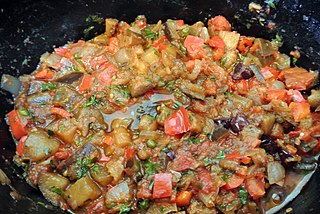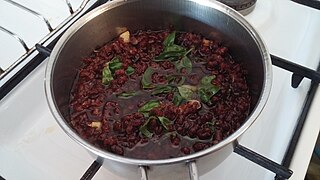
Sicilian cuisine is the style of cooking on the island of Sicily. It shows traces of all cultures that have existed on the island of Sicily over the last two millennia. Although its cuisine has much in common with Italian cuisine, Sicilian food also has Greek, Spanish, French, Jewish, Maghrebi, and Arab influences.

Frutta martorana is a Sicilian marzipan sweet in the form of fruits and vegetables from the provinces of Palermo and Trapani.

Arancini, also known as arancine, are Italian rice balls that are stuffed, coated with breadcrumbs and deep-fried. They are a staple of Sicilian cuisine. The most common arancini fillings are al ragù or al sugo, filled with ragù, mozzarella or caciocavallo cheese, and often peas, and al burro or ô burru, filled with prosciutto and mozzarella or béchamel sauce.

Parmigiana, also called parmigiana di melanzane, melanzane alla parmigiana or, in the United States, eggplant parmesan, is an Italian dish made with fried, sliced eggplant layered with cheese and tomato sauce, then baked. The origin of the dish is claimed by the southern regions of Calabria, Campania, Apulia and Sicily.

Caponata is a Sicilian dish consisting of chopped fried eggplant/aubergine and other vegetables, seasoned with olive oil, tomato sauce, celery, olives, and capers, in an agrodolce sauce.

Many cuisines feature eggplant salads and appetizers.

Italian meal structure is typical of the European Mediterranean region and differs from that of Northern, Central, and Eastern Europe, although it still often consists of breakfast (colazione), lunch (pranzo), and supper (cena). However, breakfast itself is often skipped or is lighter than that of non-Mediterranean Europe. Late-morning and mid-afternoon snacks, called merenda, are also often eaten.

Cappon magro is an elaborate Genoese salad of seafood and vegetables over hardtack arranged into a decorative pyramid and dressed with a rich sauce.

The Sicilian orange salad is a typical salad dish of the Spanish and Sicilian cuisine, which uses oranges as its main ingredient. It is usually served at the beginning or at the end of a meal.

The Cipolla di Giarratana is a Sicilian variety of onion, sweet and of considerable size, with bulbs from the flattened shape which can be up to 3.5 kilograms in weight and a white-brownish tunic. It is cultivated in the comune of Giarratana, in the Hyblaean Mountains, where it is the main product of the local agriculture. A Festival, the "Sagra della cipolla", is held every August in the town.

The Aglio Rosso di Nubia, also known as Aglio di Paceco and Aglio di Trapani, is a Sicilian variety of garlic, characterized by the intense purple color of the robes of its bulbils. It is mainly cultivated in Nubia, a fraction of the comune of Paceco, in the Province of Trapani. In less extent, it is also cultivated in the neighboring municipalities of Trapani, Erice, Buseto Palizzolo, Valderice, Marsala and Salemi.
Sciusceddu is a Sicilian soup prepared using meatballs and broken eggs as primary ingredients, served as a traditional Easter dish in the city of Messina. Additional ingredients used include broth, caciocavallo and ricotta cheeses, parsley, salt and pepper. It can be prepared in a similar style to egg drop soup.

The Pantesca salad or Pantelleria salad is a typical dish of the island of Pantelleria.

The capuliato or capuliatu is a traditional condiment of Sicilian cuisine based on dried tomatoes, linked, in particular to the territory of the Vittoria Plain, in free municipal consortium of Ragusa. The original name is capuliato, meaning 'minced'.

Ligurian cuisine consists of dishes from the culinary tradition of Liguria, a region of northwestern Italy, which makes use of ingredients linked both to local production, and to imports from areas with which, over the centuries, the Ligurians have had frequent trade.
Pasta 'ncasciata is a celebratory baked pasta dish originating in the Sicilian comune (municipality) of Messina; however, today there are numerous versions from every province of Sicily and Calabria. Ingredients vary according to the region as well as personal preferences. For example, while the dish usually uses two types of cheese, béchamel sauce may be used in lieu of one of the cheeses. It was traditionally baked in a dish placed over, as well as covered by, hot coals. The dish was made more well known by Andrea Camilleri's Inspector Montalbano.




















































